Water in Permeable Building Materials
Robyn Pender
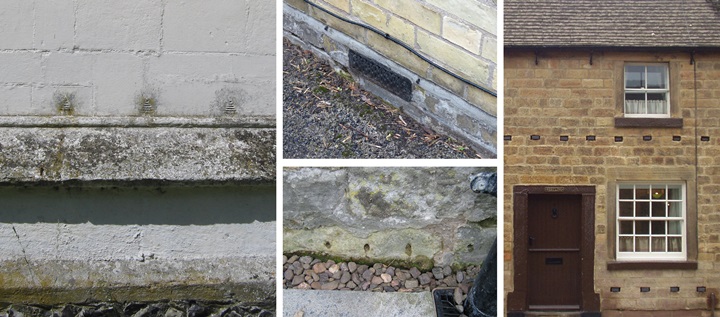 |
|
| Failed remedial treatments are often based on wrong notions about the behaviour of water. The operation of Knapen tubes, for example, is based on the idea that humid air is heavy and so will fall. In reality, humid air rises. |
The critical links between water and almost every form of building deterioration do not need repeating here, nor does the fact that porous materials interact closely with moisture. On the other hand – as the various claims for miracle remedial products make clear – the mechanisms by which water moves into and through building materials are not so well understood.
Does this matter? The problem is that, when it comes to dealing with moisture problems, correct identification of the source is vital: treating symptoms simply does not work, because very different problems lead to almost the same symptoms, and ‘feedback loops’ are common (moisture causing damage that lets in more moisture). To complicate matters, the same words are used by laboratory scientists, building investigators and practitioners, but they are used to mean subtly different things, and this can lead to considerable confusion.
Although at microscopic level, the behaviour of water and contaminants such as salts is likely to occupy researchers for many years to come, it is not difficult for practitioners to develop a picture of the processes involved at building level that is good enough to underpin effective surveying and remediation. This paper outlines one such picture, based on the more detailed and wide-ranging explanations in the Building Environment volume of Historic England’s Practical Building Conservation series.
WHAT DO WE MEAN BY ‘PERMEABLE’?
It seems sensible to begin by disentangling the words ‘permeable’, which is used technically to describe any material through which a particular liquid or gas can pass, and ‘porous’, which in this context simply means that the structure of the material includes voids or ‘pores’ (porosity being the ratio of voids to solid matter). Not all porous materials are permeable – if the pores are bubbles cut off from each other, then nothing will be able to pass through – and some may be permeable to one liquid or gas but not another, or permeable only under certain conditions. The speed at which a liquid or gas can travel through a permeable material depends to a great extent on the shape and size of the pores, and on how they connect with each other and with the surface.
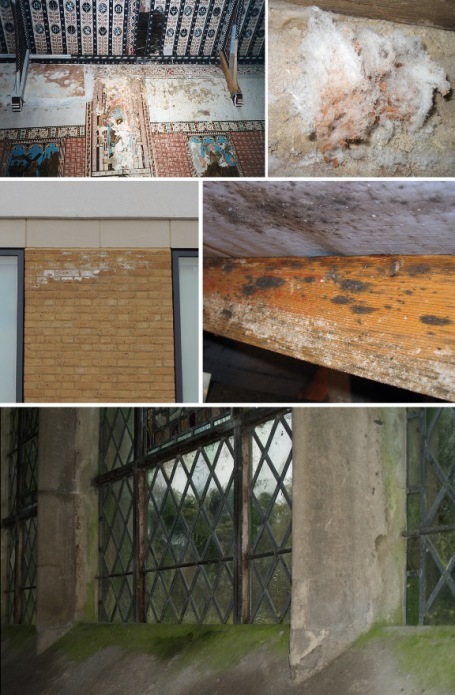 |
|
| All the familiar water-driven deterioration (salt cycling, timber decay, corrosion) requires liquid water; even where water vapour is involved, the problems arise when it condenses. |
For materials scientists, ‘permeability’ is measured by packing a column with the material of interest, and passing the liquid or gas (its ‘mobile phase’) through under pressure.
For building conservators, the mobile phase is always water (although it may well be mixed with salts and other contaminants), and the behaviour of single materials is of little interest: we are concerned with systems of multiple materials having differing densities and porosities, with many joints and voids; in movement of water in every direction, not just one; and in what happens under ordinary pressures, rather than the extreme pressures imposed in laboratory tests.
When we speak of the ‘permeability’ of a wall, it is this complex transfer of water that we actually mean.
THE BEHAVIOUR OF WATER
Which, then, of the many factors involved in moisture movement is it critical for practitioners to understand?
Water is so familiar to us that its strangeness is often forgotten, but its behaviour both physically and chemically really is peculiar.
Most materials are densest in their solid form, but ice is lighter (and so floats). At less than a nanometer in diameter, water molecules are tiny: smaller and lighter than the air molecules they displace (oxygen, nitrogen, argon and carbon dioxide), and with so little mass that gravity has no effect: humid air is therefore buoyant and rises. At room temperature, most other small molecules are gases, but water is liquid because its boiling point is very high.
The underlying reason for many of water’s special characteristics is the structure of the molecule. Water is a ‘polar’ molecule: its electron cloud is not evenly distributed; instead the two hydrogen atoms are twinned together and form a positive charge, whereas the single oxygen atom is negatively charged. As a result it reacts strongly with electrical fields, as well as with many surfaces and with other charged particles. This includes other water molecules, so the liquid has an unusually high surface tension, and forms a very strong ‘meniscus’ (the surface separating the liquid from the air). For the same reason, liquid water flows, is an excellent solvent, and it transmits an electrical current with ease.
WHAT THE STANDARD ‘HUMIDITY’ TERMS MEAN
The common terms describing humidity all refer to water molecules in free air. The ‘absolute humidity’ (AH) is the actual number of molecules (by weight per area or volume). ‘Vapour pressure’ (Vp) is most easily envisaged by imagining the air inside a box. The molecules will be bouncing around at speeds that depend primarily on the air temperature (which gives them their energy), and the Vp is the pressure the molecules exert on the walls of the box as they hit; more collisions means a higher Vp. Vp can therefore be increased in two ways: by adding more molecules to the box, or by increasing the temperature.
Each time the molecules collide with each other, it is likely they will lose some of their energy, and eventually they will no longer have enough momentum to break away again (that is, they will ‘condense’). Eventually droplets of water form (mist; then – when the droplets are massive enough for gravity to take effect – dew, and eventually rain).
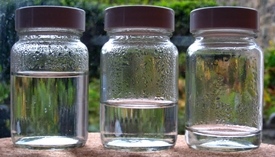 |
|
| The air inside all three sealed bottles is saturated (as shown by the condensation) and this is independent of the water level. There are more than a ‘vigintillion’ (1 followed by 120 zeros) water molecules in a single drop of water, so the reservoir needed to reach saturation is tiny. |
Molecules will also lose energy when they collide with a surface; and the colder the surface, the more energy they will lose, making condensation increasingly likely. A condensed molecule can break away again – ‘evaporate’ – if it gains energy (heat, perhaps, or momentum from being hit by another molecule), and in practice condensation and evaporation are happening continually.
The number of molecules that air can hold depends on its temperature and AH (that is, on the number of collisions occurring). At some point the number of molecules condensing will be balanced by the number evaporating so the air will be holding as much water as it can (‘saturation’).
Air will not generally be saturated unless it is in a closed space together with a source of water molecules, so the humidity of the air is commonly expressed as ‘relative humidity’ (RH), which is the percentage of saturation (the amount of water molecules actually in the air, compared to the amount it could potentially hold at that temperature). Air at 80 per cent relative humidity will be holding many more water molecules if the temperature is 25 degrees than if it is 15 degrees. To increase the RH, either the AH must be increased, or the temperature must be decreased, or both.
THE IMPORTANCE OF LIQUID WATER
Water vapour is often the principal topic raised by building physicists, but when it comes to understanding deterioration, liquid water is of infinitely greater importance. It is affected by gravity, so water from a leaking gutter will quickly find a path through the pores of the materials and flow down to collect at the base of the wall; this is a common cause of so-called ‘rising damp’. In pores, however, gravity is only one of the possible forces driving movement. Just as important is the pressure difference on either side of the meniscus: in ‘capillaries’ (fine interlinked pores, cracks, or thin gaps between flat materials) this is easily strong enough to move water, and even lift it against gravity.
The mechanisms behind ‘capillary transfer’ were first understood by WT Thompson (later Lord Kelvin), who built on Young’s and Laplace’s work on menisci. The curvature of a meniscus depends on the forces between the water and the surface it touches, so where these forces are high, a drop of water on a surface is quite flat, whereas on material with which water does not interact the droplet will be sharply curved.
It was Kelvin’s great insight that the Vp of the air above the meniscus will depend on this curvature – convex menisci raising the Vp and concave menisci lowering it – and that this could explain the behaviour of water in a straw. The interaction with the straw’s walls forms a concave meniscus that, for a thin straw, reduces the Vp enough to lift the level of the water considerably (it will rise until its weight balances the force of the pressure difference). The Vp above the meniscus will be lowered still more by evaporation at the top of the straw (air flow is one of the principal drivers of moisture movement).
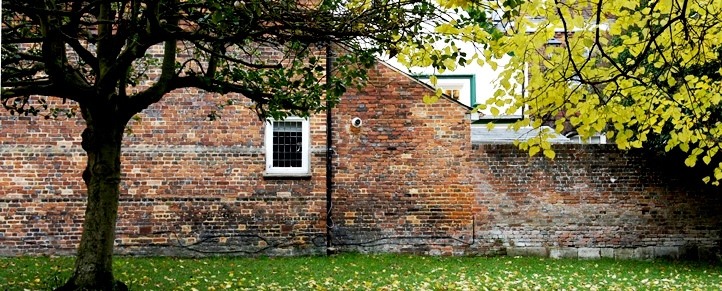 |
|
| ‘Rising damp’ is an excellent example of how many different sources of moisture can produce very similar symptoms. At the right, this wall shows the classic symptoms often attributed to capillary rise from groundwater: a zone of salt damage and staining, separating a dry area above from a wet area below. Closer examination shows that the majority of the wall is fine – which it would not be if groundwater were the issue – and that the source is in fact run-off from a glass roof behind, saturating the wall and percolating downwards. Other common causes of this damage pattern include splash-back and plumbing leaks. |
Capillary transfer is the main mechanism by which trees bring water and nutrients through their roots and up to their leaves, and is often cited as a reason for ‘rising damp’ in buildings, but in fact permeable building materials are very unlike trees: their pores are not smooth but rough and chemically active, and the pore structure is not ‘bundled straws’, but interconnected, convoluted, broken, and with many ‘mouths’ at the surface through which water can evaporate (capillary forces conduct water not just vertically but sideways as well). Water therefore rises only a very small distance (often no more than the first course of bricks, since joints of all kinds are a barrier to movement).
For substantial capillary rise, a very strong and persistent source of water is needed (such as a broken water main or sewer), and this must usually be coupled with a coating or finish that slows or prevents evaporation (such as a cement render).
WHAT HAPPENS IN THE PORES?
All these forces draw water into permeable materials, and move them around. Inside the pores, movement is also affected by other many forces, notably electrochemical reactions with the pore walls, and friction with rough and convoluted surfaces. Although it is impossible to observe exactly what happens inside a permeable material, we are fairly confident about the basic processes that must be involved. As liquid water or water vapour is drawn in, films form on the surfaces of certain pores, and these curved liquid surfaces reduce the vapour pressure (Vp), drawing in yet more water. If enough liquid collects, it begins to flow through to the neighbouring pores.
Almost everything happening inside the pores decreases the Vp, drawing in moisture, and this is why ‘waterproof’ coatings can fail so spectacularly: they cannot entirely stop water being pulled in, but they do reduce evaporation, so over time moisture levels build up.
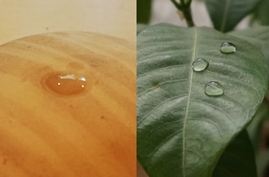 |
|
| Water will interact strongly with most surfaces. Left, a droplet of water on a surface that is ‘hydrophilic’ (“water-loving”, so reacting with water molecules); right, a droplet on a ‘hydrophobic’ surface. | |
 |
|
| For the same reason that a sponge must be slightly wet if it is to soak up a spill, dry building materials resist absorbing water. On the other hand, wet materials will draw water in quickly: the ‘moisture history’ of the material is therefore of paramount importance. |
Some forces resist the uptake of water, most importantly the pressure of the air in the pores. Some simple experiments on bricks have shown that the pressure of the air pushed through the pores ahead of water rising by capillary action alone is around 1 bar. Air pressure has been shown to be the cause of pipes bursting in cold weather, and it seems reasonable to suspect that a similar mechanism is involved in freeze-thaw damage, and perhaps also in some of the damage related to coatings and salt crystallisation.
Water will not be distributed evenly throughout the pores: some capillaries may fill, while others stay almost empty. Although an analysis of a drilled core sample might demonstrate that the fabric contains very little water, what moisture there is might be concentrated as a liquid in capillaries or cracks through which it can move easily and very quickly, carrying with it contaminants such as salts. Moreover, the situation will be dynamic, and can change very rapidly in response to air temperature and humidity changes, or air flow across the surface.
This explains the failure of many standard laboratory tests – such as those for freeze-thaw – to mimic the deterioration observable in the field. Most tests require saturating the sample, but in buildings complete saturation is extremely rare. In fact, materials are demonstrably much more at risk from salt decay and freezing temperatures if their pore structure contains air as well as water.
Water vapour in pores does not behave like liquid water. Individual water molecules will bounce around randomly, exactly as they do in the air, and will not be affected by gravity, or indeed the environmental conditions outside the material. Collisions with the pore walls will quickly lead to condensation, so it is virtually impossible for a water-vapour molecule to travel right through a permeable material of any thickness. Water vapour is most likely to be a problem if it forms enough condensation to drip or to run down as liquid. (Condensation on glass, for example, can lead to the decay or corrosion of window frames.)
THE CRITICAL IMPORTANCE OF MOISTURE HISTORY
Exactly what happens inside a permeable material as the environmental conditions change will depend on the existing distribution of water within the building materials: in other words, the ‘moisture history’ is critical to behaviour. This is the key to understanding puzzling observations such as the fact that although, in theory, driving rain cannot “get through” a wall, in some cases it can be seen to cause moisture problems on the interior; or that in the laboratory permeable materials buffer humidity much less well than they do in real buildings.
To take the example of driving rain, the supply of liquid to the pores is by no means continuous (as it is, say, with a Karsten tube); even in the most violent storm it is highly unlikely that two consecutive raindrops will hit the same pore. This means that the rain will not generally penetrate beyond the first millimetre or so. If, however, a good number of capillaries are already filled with water from some other cause (such as a leaking gutter), and the raindrop stands a good chance of hitting the mouth of a wet capillary, it can be drawn in; and if that capillary is filled with liquid and connects to the interior surface of the wall, then evaporation can quickly wick the rain right through.
Another apparently confusing observation is that rapid drying after flooding tends to fail: after a few weeks the surfaces are once again wet and covered with mould. This comes down to the difference between liquid and vapour movement, which causes drying to proceed in two stages. In the first stage, liquid-filled capillaries connect the water inside the material to the surface, so evaporation can quickly draw it out. Eventually, however, the speed of evaporation will exceed the speed that water can travel through the capillary, and the liquid stream will be broken. Across the break, water must travel as a vapour rather than a liquid, so immediately the drying rate plummets. This second stage of drying will continue until the water inside the material has moved around enough to once again establish a liquid ‘flow path’ to the surface.
Trying to dry a flooded building too quickly is counterproductive; effective drying is slow and steady, staying in the first stage for as long as possible.
PUTTING KNOWLEDGE INTO PRACTICE
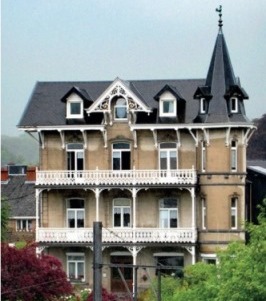 |
|
| Traditional features such as wide overhangs and hood mouldings were designed to keep water from entering the wall at weak points, keeping the walls dry and allowing them to resist driving rain. |
Analysis of building moisture problems does not mean checking to see that standard water-handling features are in place, so much as looking for the signs of failure. Water cares nothing for our intentions, and will never flow into a drain if the drain is higher, just because it is a drain, nor enter a drying vent only when dry, and then leave again conveniently as soon it has picked up moisture.
It is critical to keep an open mind about the source of the water. It is all too easy to develop complicated scenarios, when in fact on closer consideration the cause is quite straightforward. Common sources that are often overlooked include plumbing leaks and routine cleaning. We use much more water for cleaning than in the past: for example, decay on the inside of a window frame is now more likely to be caused by routinely washing the window than by condensation.
The construction techniques used in the past are also often overlooked or misunderstood by those repairing them, sometimes with disastrous consequences. Today most construction is based on ‘waterproof’ materials down which rain flows rather than being absorbed.
If we look at traditional construction in the light of water behaviour, it is immediately evident why it has worked so well: it is the result of refinements by generations of observant builders who understood how to make optimum use of the many advantages of permeable materials.



